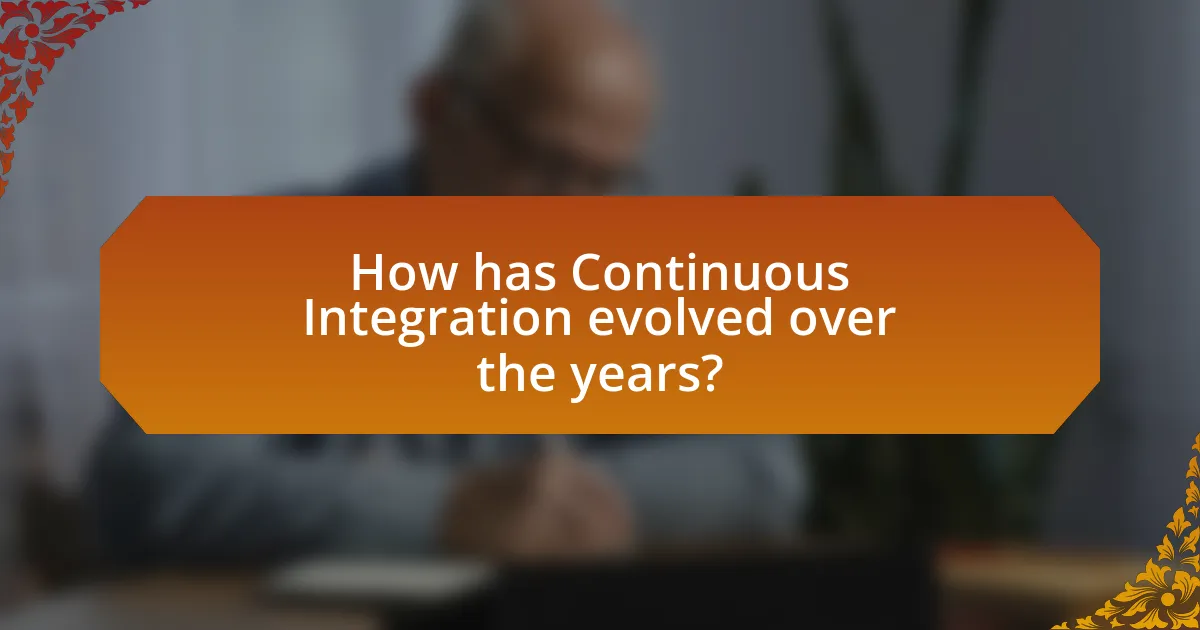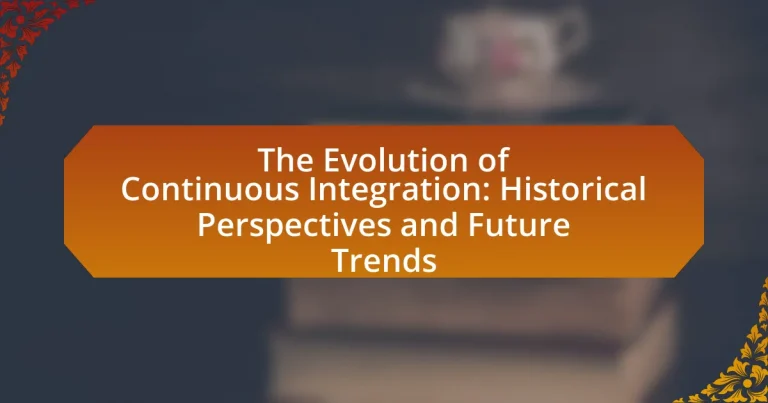The article focuses on the evolution of Continuous Integration (CI), a software development practice that emphasizes frequent code integration into a shared repository, automated testing, and immediate feedback. It outlines the historical origins of CI, key figures who contributed to its development, and the core principles that underpin its effectiveness in improving software quality and reducing integration issues. The article also discusses the technological advancements that have influenced CI, including automation tools and cloud computing, as well as current trends such as the integration of artificial intelligence and microservices architecture. Additionally, it highlights best practices for successful CI implementation and strategies to overcome common challenges, providing a comprehensive overview of CI’s past, present, and future.

What is Continuous Integration and Why is it Important?
Continuous Integration (CI) is a software development practice where developers frequently integrate their code changes into a shared repository, followed by automated builds and tests. This practice is important because it helps detect and address integration issues early, reduces the time spent on debugging, and improves software quality. According to a study by the DevOps Research and Assessment (DORA) team, organizations that implement CI can achieve 46 times more frequent code deployments and 96 times faster mean time to recover from failures, demonstrating its effectiveness in enhancing development efficiency and reliability.
How did Continuous Integration originate?
Continuous Integration originated in the late 1990s as a software development practice aimed at improving code quality and reducing integration problems. The concept was popularized by Martin Fowler in his 2000 article “Continuous Integration,” where he emphasized the importance of integrating code into a shared repository frequently, ideally multiple times a day. This practice emerged from the need to address the challenges of traditional software development, where long integration cycles often led to significant bugs and delays. The adoption of Continuous Integration has since been supported by advancements in automation tools and methodologies, reinforcing its role in modern software development.
What were the early practices that led to the development of Continuous Integration?
The early practices that led to the development of Continuous Integration (CI) include version control systems, automated testing, and frequent code integration. Version control systems, such as CVS and Subversion, allowed developers to manage changes to code collaboratively, which laid the groundwork for integrating code frequently. Automated testing practices emerged to ensure that new code did not break existing functionality, promoting a culture of quality assurance. Additionally, the practice of integrating code into a shared repository multiple times a day, as advocated by pioneers like Martin Fowler and the Agile Manifesto, emphasized the importance of early detection of integration issues. These foundational practices collectively contributed to the establishment of CI as a standard in software development.
Who were the key figures in the history of Continuous Integration?
The key figures in the history of Continuous Integration include Martin Fowler, who popularized the concept through his writings and advocacy for Agile methodologies, and Kent Beck, who developed Extreme Programming, which emphasizes frequent integration. Additionally, Grady Booch contributed to the foundational practices of software engineering that support CI principles. These individuals played significant roles in shaping the practices and philosophies that underpin Continuous Integration today.
What are the core principles of Continuous Integration?
The core principles of Continuous Integration (CI) include frequent code integration, automated testing, and immediate feedback. Frequent code integration ensures that developers merge their changes into a shared repository multiple times a day, which helps to identify integration issues early. Automated testing involves running tests automatically on each integration to verify that the new code does not break existing functionality. Immediate feedback allows developers to receive prompt notifications about the success or failure of their integrations, enabling quick resolution of issues. These principles collectively enhance software quality and streamline the development process, as evidenced by studies showing that teams practicing CI experience fewer integration problems and faster delivery times.
How do automated testing and version control contribute to Continuous Integration?
Automated testing and version control are essential components of Continuous Integration (CI) as they ensure code quality and facilitate collaboration among developers. Automated testing allows for immediate feedback on code changes, enabling teams to identify and fix issues quickly, which is crucial for maintaining a stable codebase. Version control systems, such as Git, manage changes to the code, allowing multiple developers to work simultaneously without conflicts, and providing a history of changes that can be reviewed and reverted if necessary. Together, these tools streamline the integration process, reduce the risk of errors, and enhance the overall efficiency of software development, as evidenced by studies showing that teams employing CI practices experience fewer integration issues and faster release cycles.
What role does collaboration play in Continuous Integration?
Collaboration is essential in Continuous Integration as it fosters communication and coordination among team members, leading to more efficient development processes. Effective collaboration allows developers to share code changes frequently, which minimizes integration issues and enhances code quality. According to a study by the Agile Alliance, teams that prioritize collaboration in CI practices report a 30% increase in deployment frequency and a 50% reduction in lead time for changes. This evidence underscores the critical role that collaboration plays in achieving the goals of Continuous Integration.
What challenges did Continuous Integration face in its early adoption?
Continuous Integration faced several challenges during its early adoption, primarily including resistance to change, integration complexity, and inadequate tooling. Organizations were often hesitant to shift from traditional development practices to Continuous Integration due to established workflows and cultural inertia. The complexity of integrating various systems and tools posed significant technical hurdles, as teams struggled to automate builds and tests effectively. Additionally, the lack of mature tools and frameworks at the time made it difficult to implement Continuous Integration practices seamlessly, leading to inconsistent results and frustration among developers. These challenges hindered widespread adoption and required significant effort to overcome as the methodology evolved.
How did technological limitations impact the growth of Continuous Integration?
Technological limitations significantly hindered the growth of Continuous Integration (CI) by restricting the speed and efficiency of software development processes. Early CI practices were constrained by inadequate computing power, slow internet speeds, and limited automation tools, which made it challenging to integrate code changes frequently and reliably. For instance, before the widespread availability of cloud computing and robust version control systems, developers faced difficulties in managing code repositories and automating build processes, leading to longer integration cycles and increased chances of integration errors. These limitations resulted in a slower adoption of CI methodologies, as teams struggled to implement the necessary infrastructure and tools to support continuous integration effectively.
What cultural barriers existed in organizations regarding Continuous Integration?
Cultural barriers that existed in organizations regarding Continuous Integration include resistance to change, lack of collaboration, and siloed teams. Resistance to change often stemmed from established workflows and fear of disrupting existing processes, which hindered the adoption of Continuous Integration practices. Lack of collaboration was prevalent as teams operated in isolation, leading to communication gaps and a reluctance to share code or integrate frequently. Siloed teams, particularly in larger organizations, created environments where developers, testers, and operations personnel did not work together effectively, further complicating the implementation of Continuous Integration. These barriers were documented in studies such as “The State of DevOps Report,” which highlights the importance of cultural alignment in achieving successful DevOps practices, including Continuous Integration.

How has Continuous Integration evolved over the years?
Continuous Integration (CI) has evolved significantly since its inception in the late 1990s, transitioning from manual integration processes to automated systems that enhance software development efficiency. Initially, CI focused on integrating code changes into a shared repository multiple times a day, primarily to detect integration issues early. Over the years, the introduction of tools like Jenkins in 2011 and Travis CI in 2011 automated these processes, allowing for continuous testing and deployment.
By the mid-2010s, CI practices expanded to include Continuous Delivery (CD), enabling teams to release software more frequently and reliably. The adoption of cloud-based CI/CD services further streamlined workflows, allowing for scalable and flexible integration environments. As of 2023, CI has integrated with DevOps practices, emphasizing collaboration between development and operations teams, and leveraging containerization technologies like Docker to enhance deployment consistency. This evolution reflects a shift towards more agile methodologies, with a focus on rapid feedback loops and improved software quality.
What technological advancements have influenced Continuous Integration?
Technological advancements that have influenced Continuous Integration include the rise of cloud computing, containerization, and automation tools. Cloud computing has enabled scalable and flexible environments for testing and deployment, allowing teams to integrate code more frequently and reliably. Containerization, exemplified by technologies like Docker, has facilitated consistent environments across development, testing, and production, reducing integration issues. Automation tools, such as Jenkins and Travis CI, have streamlined the build and testing processes, enabling faster feedback loops and reducing manual errors. These advancements collectively enhance the efficiency and effectiveness of Continuous Integration practices in software development.
How have cloud computing and DevOps practices reshaped Continuous Integration?
Cloud computing and DevOps practices have significantly reshaped Continuous Integration (CI) by enabling faster, more efficient development cycles and enhancing collaboration among teams. The integration of cloud services allows for scalable infrastructure, which facilitates automated testing and deployment processes, reducing the time from code commit to production. Additionally, DevOps emphasizes a culture of collaboration and continuous feedback, which aligns with CI principles, leading to improved code quality and quicker resolution of issues. According to the 2021 State of DevOps Report, organizations that implement DevOps practices experience 46 times more frequent code deployments and 440 times faster recovery from failures, demonstrating the tangible benefits of these methodologies on CI processes.
What tools have emerged to support Continuous Integration processes?
Tools that have emerged to support Continuous Integration processes include Jenkins, Travis CI, CircleCI, GitLab CI, and Bamboo. Jenkins, an open-source automation server, allows developers to build, test, and deploy code continuously, with over 1,500 plugins available to support various tasks. Travis CI integrates directly with GitHub, enabling automated testing and deployment for projects hosted there. CircleCI offers a cloud-based solution that optimizes build performance and integrates with various version control systems. GitLab CI, part of the GitLab platform, provides a seamless experience for CI/CD within the same interface as version control. Bamboo, developed by Atlassian, integrates with other Atlassian products and supports automated builds and deployments. These tools have significantly enhanced the efficiency and reliability of Continuous Integration processes in software development.
What are the significant milestones in the history of Continuous Integration?
The significant milestones in the history of Continuous Integration (CI) include the introduction of the concept in the late 1990s, the publication of Martin Fowler’s article on CI in 2000, and the development of CI tools like CruiseControl and Jenkins in the early 2000s. In 2001, the Agile Manifesto emphasized CI as a core practice, further popularizing it. By 2011, the rise of cloud-based CI services, such as Travis CI and CircleCI, marked a shift towards more accessible CI solutions. These milestones collectively demonstrate the evolution of CI from a niche practice to a fundamental aspect of modern software development, enhancing collaboration and code quality.
How did the introduction of Agile methodologies impact Continuous Integration?
The introduction of Agile methodologies significantly enhanced Continuous Integration (CI) by promoting iterative development and frequent code integration. Agile practices emphasize collaboration, flexibility, and rapid feedback, which align closely with CI principles that advocate for integrating code changes regularly to detect issues early. This synergy led to the adoption of automated testing and deployment processes within CI, ensuring that code is continuously validated against user requirements. As a result, Agile methodologies have driven the evolution of CI tools and practices, making them more efficient and responsive to changing project needs.
What role did open-source projects play in the evolution of Continuous Integration?
Open-source projects significantly advanced the evolution of Continuous Integration (CI) by providing accessible tools and frameworks that fostered collaboration and innovation. These projects, such as Jenkins and Travis CI, enabled developers to automate testing and deployment processes, which are core components of CI practices. The widespread adoption of these tools in the developer community facilitated the sharing of best practices and methodologies, leading to a more standardized approach to CI. Furthermore, the open-source nature of these projects allowed for rapid iteration and improvement, as contributors from around the world could enhance features and fix bugs, thereby accelerating the overall development cycle. This collaborative environment has been crucial in establishing CI as a fundamental practice in modern software development.
What are the current trends in Continuous Integration?
Current trends in Continuous Integration (CI) include the adoption of cloud-based CI solutions, increased automation through AI and machine learning, and a focus on DevOps practices. Cloud-based CI tools, such as GitHub Actions and GitLab CI, enable teams to scale their CI processes efficiently and reduce infrastructure management overhead. Automation is enhanced by AI-driven tools that optimize testing and deployment processes, leading to faster feedback loops. Additionally, the integration of CI with DevOps emphasizes collaboration between development and operations teams, streamlining workflows and improving software delivery speed. These trends reflect the industry’s shift towards more agile and efficient development practices.
How is Artificial Intelligence being integrated into Continuous Integration practices?
Artificial Intelligence is being integrated into Continuous Integration practices primarily through automation and predictive analytics. AI enhances the efficiency of CI pipelines by automating testing processes, identifying code vulnerabilities, and predicting potential integration issues before they arise. For instance, tools like AI-driven test automation frameworks can analyze historical test data to optimize test coverage and execution time, significantly reducing manual effort and increasing reliability. Additionally, AI algorithms can analyze patterns in code changes and past integration failures, allowing teams to proactively address issues, thereby improving overall software quality and deployment speed.
What is the impact of microservices architecture on Continuous Integration?
Microservices architecture significantly enhances Continuous Integration (CI) by enabling faster and more efficient development cycles. This architectural style allows teams to develop, test, and deploy services independently, which accelerates the integration process. According to a study by the DevOps Research and Assessment (DORA) team, organizations that adopt microservices can achieve deployment frequencies that are 200 times higher than those using monolithic architectures. This increased frequency is attributed to the ability to isolate changes and reduce the risk of system-wide failures during integration. Additionally, microservices facilitate automated testing and continuous delivery pipelines, further streamlining the CI process.

What does the future hold for Continuous Integration?
The future of Continuous Integration (CI) is characterized by increased automation, integration with artificial intelligence, and enhanced collaboration among development teams. As organizations strive for faster delivery cycles, CI tools will evolve to incorporate machine learning algorithms that can predict build failures and optimize testing processes. According to a report by GitLab, 70% of organizations are already adopting CI/CD practices, indicating a strong trend towards automation and efficiency in software development. This shift will lead to more seamless integration of CI with DevOps practices, fostering a culture of continuous improvement and rapid feedback loops.
How will Continuous Integration adapt to emerging technologies?
Continuous Integration (CI) will adapt to emerging technologies by integrating automation, artificial intelligence, and cloud-native practices into its workflows. Automation will streamline testing and deployment processes, allowing for faster feedback loops and more efficient code integration. AI will enhance CI by predicting potential integration issues and optimizing resource allocation, thereby improving overall software quality. Cloud-native practices will enable CI to leverage scalable infrastructure, facilitating seamless integration across distributed teams and environments. These adaptations are supported by industry trends indicating that organizations adopting AI and cloud technologies experience up to 30% faster release cycles and improved collaboration among development teams.
What potential does machine learning have in enhancing Continuous Integration processes?
Machine learning has significant potential to enhance Continuous Integration (CI) processes by automating error detection and optimizing build performance. By analyzing historical data from previous builds, machine learning algorithms can identify patterns that lead to failures, allowing for proactive measures to be taken before issues arise. For instance, a study by Google demonstrated that machine learning models could predict build failures with up to 90% accuracy based on past data, significantly reducing the time developers spend troubleshooting. Additionally, machine learning can optimize resource allocation during CI processes, ensuring that builds are executed more efficiently, which can lead to faster deployment cycles.
How might the rise of low-code/no-code platforms affect Continuous Integration?
The rise of low-code/no-code platforms is likely to streamline Continuous Integration (CI) processes by enabling faster development cycles and reducing the need for extensive coding expertise. These platforms allow users to create applications through visual interfaces, which can lead to quicker deployment and integration of new features. As a result, CI practices may evolve to accommodate the increased pace of development, necessitating more automated testing and integration tools that can handle a diverse range of application types. This shift is supported by the growing adoption of low-code/no-code solutions, which, according to a Gartner report, is projected to account for over 65% of application development by 2024, thereby significantly impacting traditional CI workflows.
What best practices should organizations adopt for Continuous Integration moving forward?
Organizations should adopt automated testing, frequent commits, and a robust version control system as best practices for Continuous Integration moving forward. Automated testing ensures that code changes are validated quickly, reducing the likelihood of defects in production; studies show that teams using automated testing can identify issues up to 90% faster than those relying on manual testing. Frequent commits encourage smaller, incremental changes, which facilitate easier troubleshooting and integration; research indicates that teams practicing frequent commits experience 30% fewer integration issues. A robust version control system, such as Git, allows for better collaboration and tracking of changes, which is essential for maintaining code quality and history. These practices collectively enhance the efficiency and reliability of the Continuous Integration process.
How can teams ensure effective collaboration in Continuous Integration environments?
Teams can ensure effective collaboration in Continuous Integration environments by implementing clear communication protocols and utilizing collaborative tools. Establishing regular stand-up meetings and using platforms like Slack or Microsoft Teams fosters real-time communication, allowing team members to discuss progress and address issues promptly. Additionally, employing version control systems such as Git enables multiple developers to work on the same codebase simultaneously while tracking changes, which minimizes conflicts and enhances collaboration. Research indicates that teams using these practices experience a 20-30% increase in productivity, as they can quickly resolve misunderstandings and maintain alignment on project goals.
What strategies can be implemented to overcome common Continuous Integration challenges?
To overcome common Continuous Integration challenges, organizations can implement strategies such as automating testing processes, adopting a microservices architecture, and ensuring consistent environments across development and production. Automating testing reduces manual errors and speeds up feedback loops, which is crucial for maintaining code quality. A microservices architecture allows teams to work independently on different components, minimizing integration issues. Consistent environments, achieved through containerization technologies like Docker, ensure that code behaves the same way in all stages of development, reducing deployment failures. These strategies are supported by industry practices that emphasize the importance of automation and environment consistency in successful Continuous Integration implementations.
What are the key takeaways for implementing Continuous Integration successfully?
The key takeaways for implementing Continuous Integration (CI) successfully include establishing a robust automated testing framework, ensuring frequent code commits, and maintaining a reliable build process. A robust automated testing framework allows for immediate feedback on code changes, which is essential for identifying issues early. Frequent code commits, ideally multiple times a day, help to minimize integration problems and keep the codebase up to date. A reliable build process ensures that the software can be built and deployed consistently, reducing the risk of errors during integration. These practices are supported by industry standards, such as the Agile methodology, which emphasizes iterative development and continuous feedback, leading to improved software quality and faster delivery times.


